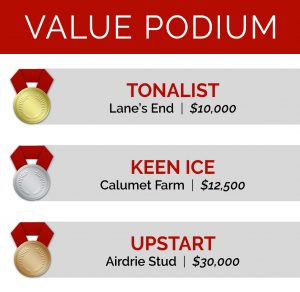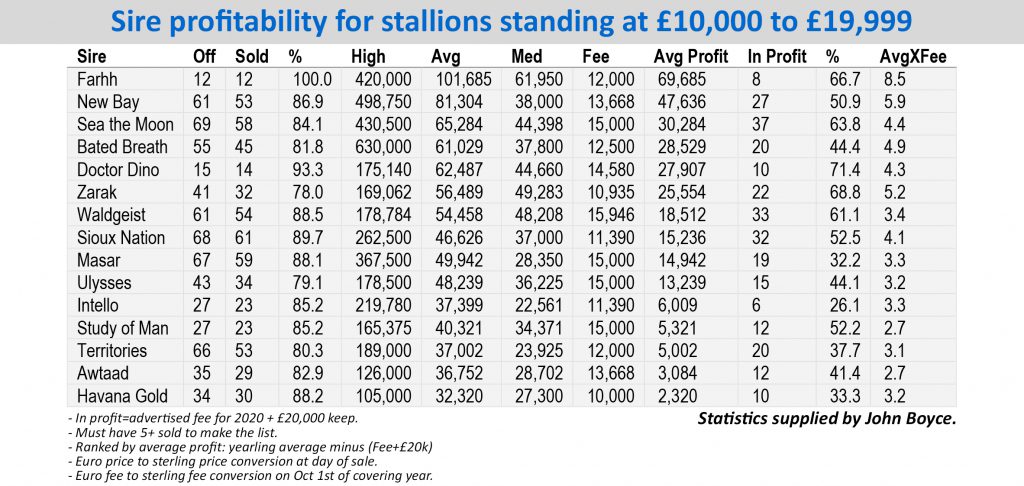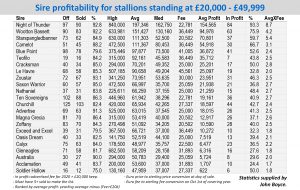And so we come to the abyss: that giddy phase between launching your first juveniles and being able to claim a viable niche in this most unforgiving of marketplaces.
Yes, for those few young stallions that do manage to seize their fleeting opportunity, a narrow path can rise rapidly towards lucrative heights. Most of the others, however, find themselves clinging to a crumbling ledge. Whatever you do, don't look down!
It's easy to disparage the robotic tendencies of the commercial market. Too easy, certainly, for me to have neglected the opportunity to do so quite regularly during this series. On the other hand, however skewed, it's an environment that creates legitimate values of its own. It may seem ludicrous that young stallions should be written off on the basis of a single crop, but the reality is that they will typically have received their biggest and best books in their rookie year. The freshman who lives by hype must also expect to die by hype.
As a result, having hitherto reviewed five intakes individually, today we combine three different classes at various stages of the same process: “earning their stripes”, as we've called it.
In the previous instalment, the first to deal with sires that have actually had some initial racetrack exposure, we felt able to persevere with our high hopes for a horse like Accelerate on the basis that it plainly remains far too soon to reach any conclusions about whether his stock can emulate his own, slow-maturing template. But sires that are only a little farther along the road have, in varying degrees, at least had a more meaningful test of their competence to recycle their prowess.
In each of the three groups combined today, a single horse has broken out immediately before consolidating to become a member of the six-figure club: Gun Runner, Not This Time and Constitution. They have respectively had one, two and three crops show what they can do round a second turn with sophomore maturity. The difficulty is that while few commercial breeders can afford the kind of fees now commanded by these three, even fewer will persevere with those other sires whose fees and reputations have begun to slide. Because everybody knows that those governing ringside investment will be timidly following the herd–and if things are already starting to look ominous for a stallion, then it certainly takes plenty of courage to persevere in the hope of a major turnaround before the 2025 yearling sales.
For the agents and managers, a terrifying risk isn't the unproven new stallion, no matter how flimsy his credentials. It's the horse that everyone else has abandoned, on however cursory a basis. Of course, if you still fervently believe in such a horse, you get the same genetic package for far less money. But that will only represent “value” to the few who remain prepared to play a longer game: either as end users, or as breeders farsighted enough to understand that there should be nothing more commercial than putting a winner under your mare. For everyone else, wanting or needing to trouser a profit as soon as possible, “value” can only be found in anticipating demand.
As I've repeatedly acknowledged in this series, that demand is partly predicated on its self-fulfilling nature. If so many mares are simply moved from one rookie to the next, then it's unsurprising if you get the kind of dividends we saw with the freshmen of 2022–who accounted for seven of the top 14 in the all-comers' juvenile prize money table.
But there's another side to the same coin. There's a stallion out there right now who was launched at a very fair fee by an outstanding farm, and duly filled his first book before looking after commercial breeders beautifully on his sales debut. Everybody, me included, thought he looked a smash. Unfortunately, he had a very quiet time with his first juveniles—and the following spring he covered SEVEN mares. Nobody, it seemed, was prepared to see whether maturity and two turns would vindicate the impression many of us had formed of his prospects. Okay, so that first crop made only mild improvement as sophomores. But who, now, would dare to roll the dice on what is now a giveaway fee? It really does seem that nowadays you get one chance, and only one, or face commercial extinction overnight.
Already, then, many of the horses we consider today look gone beyond recall: either to the rarefied fee levels achieved by Gun Runner, Not This Time and Constitution, or preparing to pack their bags during the next couple of years for overseas or regional programs. That's why we have to combine three different classes for a single podium: once you have lost the freshman limelight, you are in an open market and it's every stallion for himself.
Sometimes even those who survive this brutal process must ride out a small bump in the road. Even our old friend Not This Time–we have been on his side throughout, but can hardly keep him on a value podium at this kind of fee–was quieter with his juveniles in 2022, despite again maintaining his overall stakes action at a terrific rate. That's because they graduate from a crop of 64 live foals, conceived pending his first runners. (His mare upgrade will start to kick in with his 2024 juveniles, conceived at $40,000 from $12,500.)
Gun Runner will endure no such hiatus, albeit his second crop of juveniles understandably couldn't get anywhere near repeating the record-breaking pace set by his first. Perhaps the freshmen of 2022 will prove a stronger group than those he dominated in 2021. That's the kind of calculation required in making our choice for a combined podium, embracing stallions at different phases of consolidation.
It's a tricky undertaking, for sure, but let's see whether we can turn up some residual value somewhere.
BUBBLING UNDER:
Growing momentum for CONNECT did not really reach the sales ring in 2022, but he has some really significant reinforcements on the horizon after a bright start on the track. No fewer than 172 breeders (very much a full book by the restrained standards of his farm) thought him value at $25,000, up from 93 pending his first runners the previous year. That stampede reflects his third place in the freshman table, and growing evidence that he can get you a very good runner for that kind of money.
Connect had two “Derby” winners among his first sophomores, juvenile Grade I winner Rattle N Roll winning the GIII Oklahoma version and High Connection the one at Los Alamitos. Among his daughters, Hidden Connection has more than once flashed elite caliber; while The Alys Look, among the next crop, has already laid down a feasible Oaks marker of her own.
Having been so impressed last year with the ratios achieved by KARAKONTIE (Jpn), I was disappointed that his excellent start on the track earned him no more than 48 mares in 2022, his smallest book in four years. Still, he has a big opportunity now that the enlightened minority prepared to breed to turf stallions in Kentucky has been deprived of both Kitten's Joy and Englis Channel.
Karakontie made his Grade I breakthrough in 2022, through Spendarella in the GI Del Mar Oaks, while his overall stakes/graded stakes action has come at a superior ratio to several more expensive peers. He has also proved more versatile, in terms of surface, than many will have expected–but then he does have a very cosmopolitan pedigree. If his third dam is turf legend Miesque (Nureyev), then his mother was by Sunday Silence while his sire has dirt royalty along his maternal line.
TAPITURE has had to sieve more quantity than quality into his stats, and sure enough only has a solitary graded stakes winner (albeit a good one in millionaire Jesus' Team). Nonetheless he gets black-type action at basically 10% of named foals, no mean effort at just $7,500.
CUPID has had some pretty crazy highs and lows, in his books, but there's no arguing with a fee of $5,000 for a stallion beating 40% winners-to-named foals, including a couple at graded stakes level. Smaller breeders are really being offered quite a lot of horse for their buck here.
BRONZE: UPSTART (Flatter–Party Silks, by Touch Gold)
$30,000 Airdrie
It's the obvious stuff that has earned this fellow a hike in fee: most obviously of all, one of the most talented sophomores of the crop in Zandon, albeit the GI Blue Grass S. winner repeatedly suggested there was better to come even than third in the Derby and Travers. Among Upstart's 10 other stakes winners to date (20 black-type performers overall, representing 11% of named foals), dual Grade II winner Kathleen O. disappeared after her Oaks bid, only to make a most promising resumption in the fall. But the clincher, for me, are the ratios that most people don't consider enough.
Upstart has got over 80% of his named foals onto the track; and over 60% of them into the winner's circle. Among his most accomplished young peers, that compares to 71 and 53% respectively for Constitution; 71 and 42% for American Pharoah; 69 and 46% for Not This Time; and 64 and 36% for Nyquist. Just what is this creature made of? Tungsten?
Sure enough, in his own track career, Upstart achieved two Grade I placings in each of his three campaigns, finishing up with $1.75 million across 15 starts. (While having been forward enough for a 102 Beyer at two, some achievement for a son of Flatter.)
Upstart is cleverly named, if you look at his parentage (and damsire), but now he is clearly rising in stallion society as well. Admittedly he will do well to maintain quite so steep a climb this year, as his sophomores (including impressive recent Fair Grounds scorer Cagliostro) graduate from a book of just 38 covers. But if that is a pathetic commentary on the neurosis of the commercial market, then remember that the momentum behind this guy began even before he could show his wares on the racetrack. His first yearlings averaged six times his $10,000 starting fee, renewing traffic to 90 mares the next spring; while his first two crops both pinhooked to a six-figure average at the 2-year-old sales.
Having seen his stock on the track—and remember that his stellar 2022 sophomores emerged from no more than 86 covers–breeders were quick to fill his book last spring. His latest yearling returns, with an average soaring back up to $90,900 from $25,115 the previous year, will not discourage them from returning at his revised fee.
A fee hike doesn't automatically put a stop to value, and there's a sense that Upstart is only just getting started. With quantity already on its way, he will now have an upgrade in quality too. So here's a rare chance to enter the elevator just a level up from the lobby. Next stop is the penthouse.
SILVER: KEEN ICE (Curlin–Medomak, by Awesome Again)
$12,500 Calumet
Now this suggestion clearly comes with a few neon caveats. He's had a fairly unorthodox career to date and it tells you plenty about his commercial credibility that his latest yearlings, “boosted” by a GI Kentucky Derby winner at the first attempt, bumped along at No. 199 in the national sales averages! But I would love to have one of his daughters for a breeding program, and Rich Strike has at least made it legitimate to wonder what he might yet achieve with an upgrade in his mares.
Keen Ice always had old school appeal, in constitution and pedigree, right from when he started out.
Arguably he was never really priced to entice commercial breeders, at $20,000, and presumably had to settle primarily for plain weight of numbers from the home herd. Yet he has nonetheless proved a really prolific sire of winners (78 from 136 starters to date)—and, setting aside the ifs and buts of the Derby meltdown, Rich Strike has certainly shown a trademark durability at the top level. With the Gun Runner S. on Boxing Day the effective start of his sophomore campaign, he took in 10 starts in 11 months.
A rise to $12,500 from $7,500 hardly helps Keen Ice, in terms of overcoming commercial doubt, but I'd still say that kind of money is value for access to his sheer teak ($3.4 million across 24 starts). Remember that his maternal line extends to matriarch Too Chic (Blushing Groom {Fr}) while his eligibility as a potential broodmare sire is surely reinforced by replication of Deputy Minister: that iconic distaff influence accounts both for Keen Ice's own damsire, Awesome Again, and for the mother of his sire Curlin.
Maybe he's not the answer to everybody's prayers, but his percentage of named foals to make the starting gate, and then to win, are way ahead of the most glamorous names in his intake (with their far superior books). That shows how he's trading in the kind of stuff that any breeding program should appreciate, and it would be nice if he were granted some overdue respect after all the faint praise for his exotic Derby score.
GOLD: TONALIST (Tapit–Settling Mist, by Pleasant Colony)
Lane's End $10,000
Okay, so I understand that the megabucks earned by a single horse distort his status in the earnings table, and various associated averages. (Not dissimilar, as such, to the horse on the second step of the podium.) But I have been too loyal to Tonalist, for too long, to desert him after the year when he plundered all those desert riches with Country Grammer.
Having a poster boy like that has certainly done Tonalist no harm: he was back up to 87 mares last spring, having the previous year slumped to just 54 from 122; and he elevated his yearling average to $53,413 (for an excellent 29 sold of 31 offered) from $32,505. That's really impressive in any stallion at this awkward stage, never mind one who had been so consistently unfashionable that he had taken a fee cut every single year to 2022. His neglect always seemed mysterious to me: I loved the package at the outset (banked $3.6 million via 11 triple-digit Beyers, just as one would hope from a son of Tapit out of a Pleasant Colony granddaughter of Toll Booth) and I have loved the corresponding dependability of his output since.
He has punched above his fee throughout, especially measured by graded stakes action. In this intake Constitution has been hitting pretty mad numbers, but otherwise Tonalist's 4.5% of graded stakes operators-to-named foals is basically in step with American Pharoah and ahead of everyone else.
His template, for those who want horses that run, and keep running, is just so wholesome. Take the thriving Betsy Blue, just turned five but better than ever. It's a long time now since she broke her maiden under a $25,000 tag: on her 19th, 20th and 21st starts this winter, she placed on her graded stakes debut before winning consecutive black type prizes. Her record now reads 21-10-7-2 for $659,510. Another from the same crop, Who's The Star, took six starts to break his maiden back in 2018 but is similarly on a roll now, running up three consecutive graded stakes on his last three starts. If this guy gets in contention, you're in trouble: the only minor placings in his 17-7-1-2 record trace way back to his first maidens.
This is the kind of stuff we need to be putting into the breed: heart, resilience and “run”. Everything, in other words, we associate with Tonalist's sire and damsire. Imagine what he could do with better mares. Of course, if you happen to own one, you don't have to just imagine. You can find out, and for a near-basement fee. For everyone else trading at this kind of money, however, there aren't many better ways of affordably putting a winner under your mare.
The post Value Sires For ’23: Part VI, Earning Their Stripes appeared first on TDN | Thoroughbred Daily News | Horse Racing News, Results and Video | Thoroughbred Breeding and Auctions.




